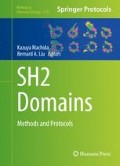Abstract
Today there exists a rapidly expanding number of sequenced genomes. Cataloging protein interaction domains such as the Src Homology 2 (SH2) domain across these various genomes can be accomplished with ease due to existing algorithms and predictions models. An evolutionary analysis of SH2 domains provides a step towards understanding how SH2 proteins integrated with existing signaling networks to position phosphotyrosine signaling as a crucial driver of robust cellular communication networks in metazoans. However organizing and tracing SH2 domain across organisms and understanding their evolutionary trajectory remains a challenge. This chapter describes several methodologies towards analyzing the evolutionary trajectory of SH2 domains including a global SH2 domain classification system, which facilitates annotation of new SH2 sequences essential for tracing the lineage of SH2 domains throughout eukaryote evolution. This classification utilizes a combination of sequence homology, protein domain architecture and the boundary positions between introns and exons within the SH2 domain or genes encoding these domains. Discrete SH2 families can then be traced across various genomes to provide insight into its origins. Furthermore, additional methods for examining potential mechanisms for divergence of SH2 domains from structural changes to alterations in the protein domain content and genome duplication will be discussed. Therefore a better understanding of SH2 domain evolution may enhance our insight into the emergence of phosphotyrosine signaling and the expansion of protein interaction domains.
Access this chapter
Tax calculation will be finalised at checkout
Purchases are for personal use only
References
Hunter T (2009) Tyrosine phosphorylation: thirty years and counting. Curr Opin Cell Biol 21(2):140–146. doi:10.1016/j.ceb.2009.01.028
Hunter T (2014) The genesis of tyrosine phosphorylation. Cold Spring Harb Perspect Biol 6(5):a020644. doi:10.1101/cshperspect.a020644
Lim WA, Pawson T (2010) Phosphotyrosine signaling: evolving a new cellular communication system. Cell 142(5):661–667. doi:10.1016/j.cell.2010.08.023
Liu BA, Engelmann BW, Nash PD (2012) The language of SH2 domain interactions defines phosphotyrosine-mediated signal transduction. FEBS Lett 586(17):2597–2605. doi:10.1016/j.febslet.2012.04.054
Manning G, Young SL, Miller WT, Zhai Y (2008) The protist, Monosiga brevicollis, has a tyrosine kinase signaling network more elaborate and diverse than found in any known metazoan. Proc Natl Acad Sci U S A 105(28):9674–9679. doi:10.1073/pnas.0801314105
Suga H, Torruella G, Burger G, Brown MW, Ruiz-Trillo I (2014) Earliest Holozoan expansion of phosphotyrosine signaling. Mol Biol Evol 31(3):517–528. doi:10.1093/molbev/mst241
King N, Carroll SB (2001) A receptor tyrosine kinase from choanoflagellates: molecular insights into early animal evolution. Proc Natl Acad Sci U S A 98(26):15032–15037. doi:10.1073/pnas.261477698, 98/26/15032 [pii]
Tan CS, Bodenmiller B, Pasculescu A, Jovanovic M, Hengartner MO, Jorgensen C, Bader GD, Aebersold R, Pawson T, Linding R (2009) Comparative analysis reveals conserved protein phosphorylation networks implicated in multiple diseases. Sci Signal 2(81):ra39. doi:10.1126/scisignal.2000316, 2/81/ra39 [pii]
Kawata T, Shevchenko A, Fukuzawa M, Jermyn KA, Totty NF, Zhukovskaya NV, Sterling AE, Mann M, Williams JG (1997) SH2 signaling in a lower eukaryote: a STAT protein that regulates stalk cell differentiation in dictyostelium. Cell 89(6):909–916
Pincus D, Letunic I, Bork P, Lim WA (2008) Evolution of the phospho-tyrosine signaling machinery in premetazoan lineages. Proc Natl Acad Sci U S A 105(28):9680–9684. doi:10.1073/pnas.0803161105, 0803161105 [pii]
Liu BA, Shah E, Jablonowski K, Stergachis A, Engelmann B, Nash PD (2011) The SH2 domain-containing proteins in 21 species establish the provenance and scope of phosphotyrosine signaling in eukaryotes. Science signaling 4(202):ra83. doi:10.1126/scisignal.2002105
Liu BA, Jablonowski K, Raina M, Arce M, Pawson T, Nash PD (2006) The human and mouse complement of SH2 domain proteins-establishing the boundaries of phosphotyrosine signaling. Mol Cell 22(6):851–868. doi:10.1016/j.molcel.2006.06.001
Serfas MS, Tyner AL (2003) Brk, Srm, Frk, and Src42A form a distinct family of intracellular Src-like tyrosine kinases. Oncol Res 13(6–10):409–419
Steele RE, Stover NA, Sakaguchi M (1999) Appearance and disappearance of Syk family protein-tyrosine kinase genes during metazoan evolution. Gene 239(1):91–97, doi:S0378-1119(99)00373-X [pii]
Colicelli J (2010) ABL tyrosine kinases: evolution of function, regulation, and specificity. Sci Signal 3(139):re6. doi:10.1126/scisignal.3139re6, scisignal.3139re6 [pii]
Finn RD, Tate J, Mistry J, Coggill PC, Sammut SJ, Hotz HR, Ceric G, Forslund K, Eddy SR, Sonnhammer EL, Bateman A (2008) The Pfam protein families database. Nucleic Acids Res 36(Database issue):D281–D288. doi:10.1093/nar/gkm960, gkm960 [pii]
Schultz J, Milpetz F, Bork P, Ponting CP (1998) SMART, a simple modular architecture research tool: identification of signaling domains. Proc Natl Acad Sci U S A 95(11):5857–5864
Letunic I, Copley RR, Pils B, Pinkert S, Schultz J, Bork P (2006) SMART 5: domains in the context of genomes and networks. Nucleic Acids Res 34(Database issue):D257–D260. doi:10.1093/nar/gkj079, 34/suppl_1/D257 [pii]
Liu BA, Nash PD (2012) Evolution of SH2 domains and phosphotyrosine signalling networks. Philos Trans R Soc Lond B Biol Sci 367(1602):2556–2573. doi:10.1098/rstb.2012.0107
O'Brien KP, Remm M, Sonnhammer EL (2005) Inparanoid: a comprehensive database of eukaryotic orthologs. Nucleic Acids Res 33(Database issue):D476–D480. doi:10.1093/nar/gki107
Tamura K, Dudley J, Nei M, Kumar S (2007) MEGA4: Molecular Evolutionary Genetics Analysis (MEGA) software version 4.0. Mol Biol Evol 24(8):1596–1599. doi:10.1093/molbev/msm092, msm092 [pii]
Shiu SH, Li WH (2004) Origins, lineage-specific expansions, and multiple losses of tyrosine kinases in eukaryotes. Mol Biol Evol 21(5):828–840. doi:10.1093/molbev/msh077, msh077 [pii]
Jin J, Xie X, Chen C, Park JG, Stark C, James DA, Olhovsky M, Linding R, Mao Y, Pawson T (2009) Eukaryotic protein domains as functional units of cellular evolution. Sci Signal 2(98):ra76. doi:10.1126/scisignal.2000546, 2/98/ra76 [pii]
Acknowledgments
I would like to thank Piers Nash, Tony Pawson, Chris Tan, and the members of the Nash and Pawson laboratory for helpful discussions. This work was supported by the Canadian Institutes of Health Postdoctoral Fellowship, Bernice Goldblatt Fellowship, Abbott Laboratories Graduate Fellowship, and the Cancer Research Foundation.
Author information
Authors and Affiliations
Corresponding author
Editor information
Editors and Affiliations
Rights and permissions
Copyright information
© 2017 Springer Science+Business Media LLC
About this protocol
Cite this protocol
Liu, B.A. (2017). Classification and Lineage Tracing of SH2 Domains Throughout Eukaryotes. In: Machida, K., Liu, B. (eds) SH2 Domains. Methods in Molecular Biology, vol 1555. Humana Press, New York, NY. https://doi.org/10.1007/978-1-4939-6762-9_4
Download citation
DOI: https://doi.org/10.1007/978-1-4939-6762-9_4
Published:
Publisher Name: Humana Press, New York, NY
Print ISBN: 978-1-4939-6760-5
Online ISBN: 978-1-4939-6762-9
eBook Packages: Springer Protocols

